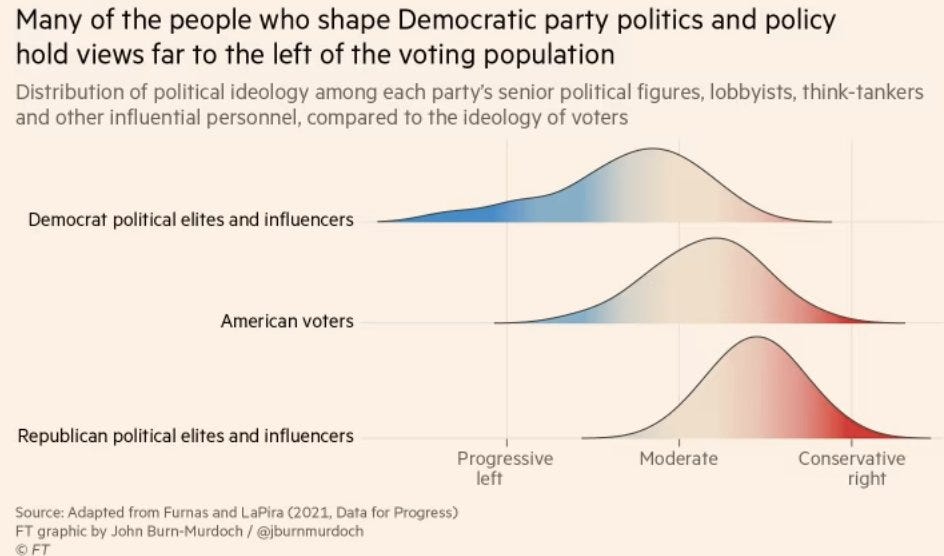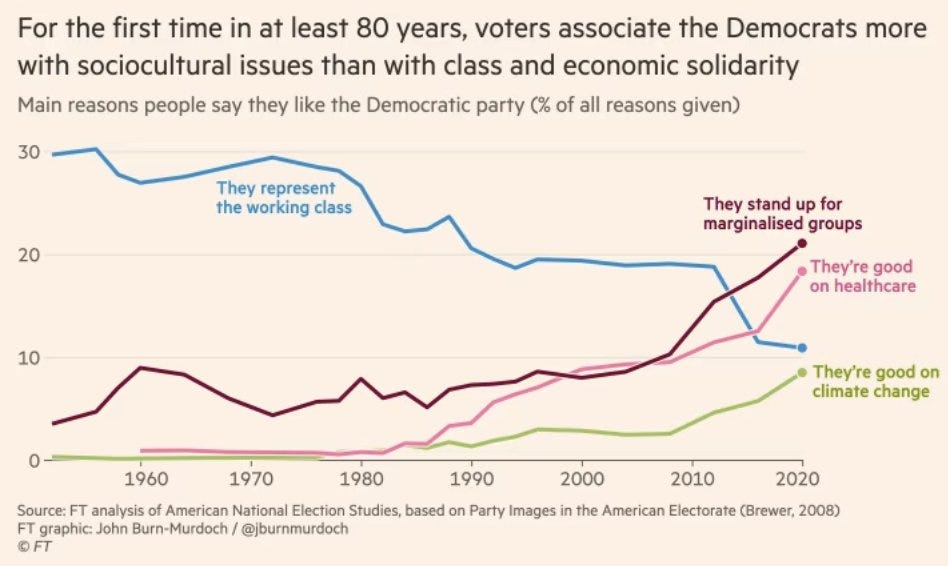The Leftward Shift in the Democratic Party: Alienating the Median American Voter?
From Working-Class Ally to ‘HR Department’: The Radical Image of Democrats
Over the past few years, the Democratic Party has moved significantly left on cultural and social issues. While this shift has strengthened its appeal to certain progressive voters, it has also distanced the party from the median American voter and left some traditionally supportive groups feeling alienated. By increasingly focusing on social justice issues, the party has risked losing its connection with working-class concerns, economic issues, and broader voter groups who do not necessarily align with its progressive cultural agenda. The following analysis, supported by recent data, explores this growing ideological divide and the potential consequences for the Democratic Party.
1. Progressive Stances on Cultural Issues: A Shift Away from the Median Voter
As the Democratic Party's policies have moved leftward, they’ve increasingly diverged from the beliefs of the average American. Issues such as affirmative action, immigration, and policing have become more polarized, with Democratic leaders and activists adopting progressive stances that are not always aligned with the broader public.
The first chart underscores this divide, showing a steady movement of Democrats toward more supportive positions on affirmative action and increased immigration, while the median voter’s position has remained relatively stable. Republicans, by contrast, have moved slightly rightward on these issues, creating a widening ideological gap between the two major parties and the general public. For many moderate Americans, this rapid shift in Democratic positions appears out of touch with their daily realities, potentially leading to a sense of alienation and disengagement.
2. The Influence of Political Elites on Party Ideology
One significant factor driving this leftward shift within the Democratic Party is the influence of political elites—lobbyists, policy advisers, activists, and other influential personnel. These elites are often deeply committed to progressive social values, which shapes the policies and rhetoric the party adopts.
The second illustration highlights this divide, showing how Democratic elites are positioned far to the left of the average American voter. While Republican elites tend to be right of center, their distance from the median American is not as pronounced as that of their Democratic counterparts. This stark ideological difference among the Democrats means that policy decisions often reflect the perspectives of a relatively small but powerful group rather than the broad base of American voters.
3. Minority and Working-Class Voters Feel Left Behind
The Democratic Party has historically been known as the party of the working class, a reputation that helped it maintain support among diverse voter groups. However, this longstanding connection appears to be weakening, as the party's focus shifts to sociocultural issues that may not resonate with all of its traditional base, particularly among minorities.
The third chart reveals that white progressive voters tend to hold significantly more left-leaning views than many minority groups, particularly on issues such as police funding and immigration. For example, while white progressives overwhelmingly support reducing police funding, Black and Hispanic voters—who are often the primary focus of social justice discussions—show less enthusiasm for such measures. This discrepancy suggests that the party’s current cultural priorities may not fully align with the values and concerns of the minority communities they aim to represent.
4. A Shift from Economic Solidarity to Sociocultural Advocacy
For decades, the Democratic Party was seen as a champion of the working class, with policies centered on economic solidarity and class issues. However, recent trends suggest that the party is increasingly associated with sociocultural causes, like supporting marginalized groups and advocating for climate change, as opposed to a strong focus on economic issues.
The final graph illustrates this trend, showing a marked rise in voters who associate the Democrats with supporting marginalized groups, healthcare, and climate change. Meanwhile, the traditional association with representing the working class has declined steadily since the 1960s. This shift in focus—from economic solidarity to sociocultural advocacy—has changed the party's image and appeal. While some voters are energized by these new priorities, others feel disconnected, seeing the party as more focused on "woke" cultural issues than practical, class-based concerns.
5. The Populist Backlash: A Warning for Democrats?
The Democratic Party’s losses in 2016 and, certainly 2024, to Donald Trump highlighted the potential consequences of disconnecting from the working-class and moderate voters. Trump’s populist message resonated with many Americans who felt overlooked by a Democratic Party increasingly preoccupied with cultural and ideological issues. His appeal was built on a platform of economic and nationalistic populism, which contrasted sharply with what he characterized as the Democrats' fixation on identity politics and political correctness.
As long as Democrats continue to prioritize out-of-touch cultural issues over economic and nation-based solidarity, they risk alienating a large swath of voters. This alienation could be particularly damaging in swing states, where moderate and working-class voters play a pivotal role in determining electoral outcomes. To regain the trust of these voters, the party may need to re-calibrate its priorities, placing greater emphasis on economic issues and everyday concerns.
Conclusion
The Democratic Party’s leftward shift on cultural issues, driven largely by progressive elites, has created a growing disconnect with the median American voter. While this movement has energized certain voter segments, it has also alienated moderates, minorities, and working-class voters who feel the party no longer represents their values and priorities. If Democrats hope to maintain a broad-based coalition and compete effectively in future elections, they may need to reconsider their current trajectory, balancing social justice advocacy with policies that resonate more closely with the everyday concerns of the average American.





